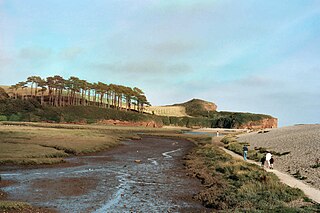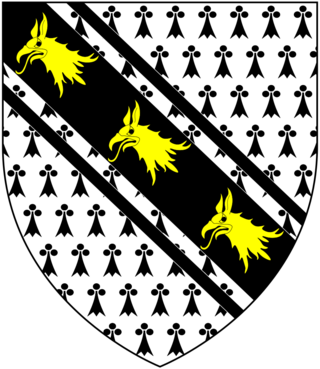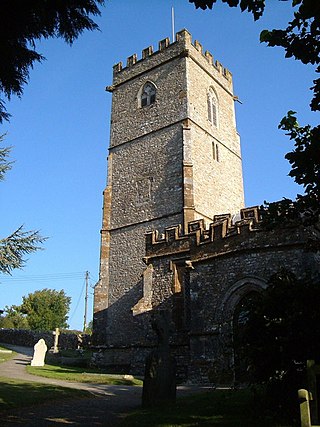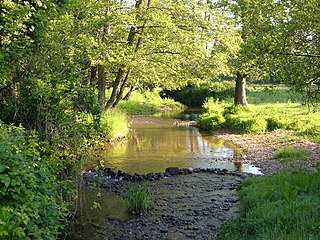
The A30 is a major road in England, running 284 miles (457 km) WSW from London to Land's End.

The A303 is a trunk road in southern England, running between Basingstoke in Hampshire and Honiton in Devon via Stonehenge. Connecting the M3 and the A30, it is part of one of the main routes from London to Devon and Cornwall. It is a primary A road throughout its length, passing through five counties.
Honiton is a market town and civil parish in East Devon, situated close to the River Otter, 17 miles (27 km) north east of Exeter in the county of Devon. Honiton has a population estimated at 11,822.
Daniel Marc Hooper, known by the nickname Swampy, is a British environmental activist. He was involved in a number of environmental protests in the 1990s, becoming nationally famous after spending a week in a tunnel aiming to stop the expansion of the A30 in Fairmile, Devon, in 1996. In 2020, he was arrested attempting to stop the destruction of Jones Hill Wood for High Speed 2 (HS2) and then joined a Stop HS2 protest at Euston Square Gardens in London.

The A35 is a major road in southern England, connecting Honiton in Devon and Southampton in Hampshire. It is a trunk road for some of its length. Most of its route passes through Dorset and the New Forest. It originally connected Exeter and Southampton, the original A35 ran along what is now the A3052 joining the present road at Charmouth.

The River Otter is a river that rises in the Blackdown Hills just inside the county of Somerset, England near Otterford, then flows south through East Devon. It enters the English Channel at the western end of Lyme Bay, part of the Jurassic Coast, a UNESCO World Heritage Site. The Permian and Triassic sandstone aquifer in the Otter Valley is one of Devon's largest groundwater sources, supplying drinking water to 200,000 people.

Sir William Yonge, 4th Baronet, of Escot House in the parish of Talaton in Devon, was an English politician who sat in the House of Commons for 39 years from 1715 to 1754.

East Devon was a UK parliamentary constituency, represented most recently in the House of Commons of the UK Parliament by Simon Jupp of the Conservative Party.

Whimple is a village and civil parish in East Devon in the English county of Devon, approximately 9 miles (14 km) due east of the city of Exeter, and 3 miles (4.8 km) from the nearest small town, Ottery St Mary. It has a population of 1,642, recounted to 1,173 for the village alone in the United Kingdom Census 2011. The electoral ward with the same name had a population of 2,380 at the above census.

Cranbrook is a new town being developed in East Devon, England, which at the 2021 census, had a population of 6,743 residents across 8 "phases". However, the town is growing at a fast pace. It is located 6 mi east-north-east of Exeter and north-west of Rockbeare, between the B3174 road and the West of England Main Line railway. The civil parish was formed on 1 April 2015.

Honiton was a parliamentary constituency centred on the town of Honiton in east Devon, formerly represented in the House of Commons of the Parliament of the United Kingdom. It sent members intermittently from 1300, consistently from 1640. It elected two Members of Parliament (MPs) until it was abolished in 1868. It was recreated in 1885 as a single-member constituency.

Sir Walter Yonge, 3rd Baronet of Escot in the parish of Talaton, Devon, was an English landowner and Whig politician who sat in the English and British House of Commons between 1679 and 1710.

Sir Walter Yonge, 2nd Baronet of Great House, Colyton, and of Mohuns Ottery, both in Devon, was a Member of Parliament for Honiton (1659), for Lyme Regis (1660) and for Dartmouth (1667–70).

Talaton is a village and a civil parish in the English county of Devon. It lies approximately 6 miles to the west of Honiton, 3 miles to the north of Ottery St Mary, 2 miles to the west of Feniton and 2 miles to the east of Whimple. The parish covers an area of 965 hectares. The parish population was estimated to be 590 in 2012.

Escot in the parish of Talaton, near Ottery St Mary in Devon, is an historic estate. The present mansion house known as Escot House is a grade II listed building built in 1837 by Sir John Kennaway, 3rd Baronet to the design of Henry Roberts, to replace an earlier house built in about 1680 by Sir Walter Yonge, 3rd Baronet (1653–1731) of Great House in the parish of Colyton, Devon, to the design of Robert Hooke, which burned down in 1808. Today it remains the home of the Kennaway baronets.

Yarcombe is a village and civil parish in the East Devon district, in the county of Devon, England, situated on the A30 road near the towns of Honiton and Chard. It is sited in the steep rolling meadows and ancient woods of the Yarty Valley on the south edge of the Blackdown Hills, an Area of Outstanding Natural Beauty. The population according to the 2011 census was 500.

Gittisham is a village and civil parish in East Devon, Devon, England, near Honiton. The village is 3 miles (5 km) from Ottery St Mary and it has a church called St Michael. The parish is surrounded, clockwise from the north, by the parishes of Awliscombe, Honiton, Sidmouth, Ottery St Mary, Feniton and Buckerell. In 2011 the parish had a population of 548.

The River Tale is a small river that drains the southern slopes of the Blackdown Hills, in Devon, England. It is a tributary of the River Otter and 8.8 miles (14.2 km) in length. Its name is derived from getæl meaning "quick, active or swift"; however, the river is noted as being "sluggish". One theory is that its name was transferred from Tala Water, a tributary of the nearby River Tamar. The river is the site of ongoing efforts to reintroduce the water vole, which is thought to be extinct in Devon.

Great House on South Street in the town of Colyton, Devon, is the remnant of an historic Elizabethan mansion house built by the Yonge family, originally prominent wool merchants in the town, later Yonge baronets. It is a grade II* listed building.
Protest tunnelling in the United Kingdom is a form of protest involving the construction of subterranean tunnels. It is typically used against the development of new road and transport infrastructure projects.
















